
Peppers are a popular vegetable plant grown for their unique flavors, colors, and heat levels. From mild and sweet to fiery hot, there are many different pepper plants available to suit every taste preference. They serve not just as an excellent enhancement to any garden but can also turn a handsome profit for agriculturists.
Of the hundreds of pepper varieties available worldwide, bell peppers, jalapeños, habaneros, serranos, and cayenne peppers are the most widely grown. Each variety of pepper plant boasts its own distinctive flavor and spice intensity, thus adding a flexible component to an array of culinary creations. Some peppers are best eaten raw, while others are more commonly used in cooked dishes like stuffed peppers, for example.
For farmers, peppers can be a profitable crop. They are considered a high-value crop, with some varieties commanding premium prices due to their unique flavor profiles, colors, and heat levels. Peppers are grown in greenhouses in the field are harvested by hand or with mechanized pickers.
Despite their popularity and profitability, peppers are a delicate plant that requires careful attention. These plants are prone to infestations and illnesses, and harsh temperatures or climatic incidents can cause harm. Careful management is essential to ensure a successful harvest. Growing peppers in a Crop Circle Garden or on a Crop Circle Farm would offer some protection from the elements.
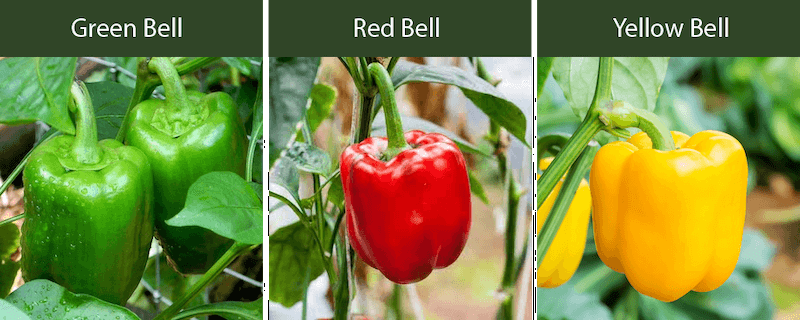
Green bell pepper plants: These pepper plants grow the most common type of bell pepper and have a mild, slightly bitter flavor. Their skin is robust and texture crisp. The signature green hue of green bell peppers is due to them being plucked while still in an unripe state. The plants are medium-sized and bushy and yield up to 20-30 peppers per plant. They prefer to grow in deep, loamy soil and require plenty of sunlight each day. Temperatures at night should not fall below 70 degrees. Green bell peppers are the perfect for stuffing.
Red bell pepper plants: These pepper plants grow red bell peppers that are fully matured green bell peppers that have been left on the vine to ripen. Red bell peppers offer a delightful combination of a sweet, succulent taste and a crisp, soft texture. They're rich in vitamin C, making them a popular choice for salads, sandwiches, and roasted delicacies. Although originating from South America, these peppers have found a place in gardens and farms across the globe. The plants are medium-sized growing to about 2 feet tall and can yield up to 5-10 peppers per plant. In tropical and sub-tropical climates bell pepper plants will need to be staked. Red bells grow best in deeply fertilizer earth in areas of the world with at least 3 continuous months of sunshine.
Yellow bell pepper plants: These pepper plants grow yellow bell peppers with a sweet, slightly tangy flavor and a crisp, tender texture. Comparable in size and form to their green and red counterparts, yellow bell peppers make excellent additions to salads, stir-fries, and dishes featuring roasted vegetables. Despite their European roots, these peppers are now cultivated extensively across various regions worldwide. The plants are medium-sized growing to a height of about 18 inches and yield up to 5-10 peppers per plant on average. They grow in deep earth cavities in climates with at least eight and a half hours of sunlight per day. To maximize production, it is imperative that nighttime temperatures remain above 70 degrees.
Orange bell pepper plants: These pepper plants grow orange bell peppers that have a sweet, slightly tangy flavor and a tender, juicy texture. Orange bell peppers, bearing resemblance in dimension and contour to yellow and red bell peppers, find their place predominantly in salads, soups, and stews. Having their origins in the Caribbean, these peppers have successfully spread their cultivation footprint across numerous global regions. The plants are medium-sized, approximately 16 inches tall and 12 inches wide producing up to 5-10 peppers per plant. Orange bells prefer to grow in composted soil mixed with animal manure and need about 9 hours of sun each day to flower and set fruit.
Purple bell pepper plants: Emerging from China, purple bell peppers have expanded their cultivation across diverse regions worldwide. With growth characteristics akin to green bell peppers, these plants can produce between 5-10 peppers per plant, contingent on the variety. Favoring soil with good drainage, these plants need a minimum of 10 hours of daily sunlight and thrive in nightly temperatures ranging between 60-70°F.
White bell pepper plants: White bell pepper plants: White bells, on the other hand, bear white bell peppers known for their gentle, somewhat sweet taste and a sturdy, crisp texture. They are less common than other colors of bell peppers and are often used for their ornamental value in dishes. Having their roots in Europe, white bell peppers are now cultivated in various regions around the globe. These plants, bearing a striking similarity in growth pattern and size to green bell peppers, can produce anywhere between 5 to 10 peppers per plant. California White peppers grow larger and yield more, averaging between 12 and 24 peppers per plant. White bells prefer to grow in 12 inch deep, well-fertilized soil. They need somewhere between 8 and 9 hours of sunlight per day and will not flower and set fruit if temperature fall below 70 degrees at night.
Chocolate bell pepper plants: Chocolate bell peppers have a rich, sweet flavor and a tender, juicy texture. They are a unique addition to dishes and are often used in desserts or in savory dishes where a sweet pepper is desired. Hailing from South America, chocolate bell peppers are currently cultivated across several regions worldwide. The plants, generally petite with a height around 12 inches, yield approximately 10 peppers per plant. Chocolate bells like to grow in manured deep cavities mixed with aged plant matter. Considered a finicky plant to grow, they flower and set fruit in a narrow temperature range of 72 to 75 degrees at night.
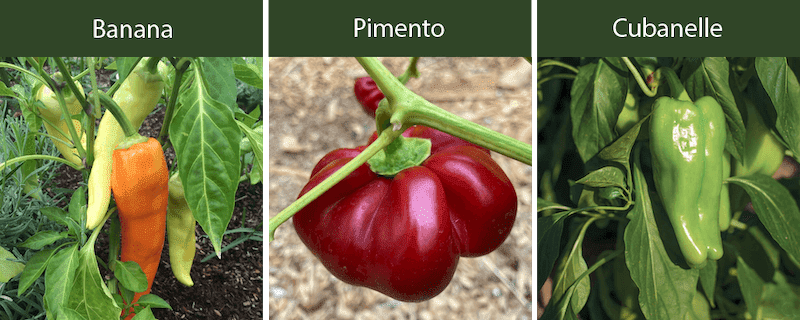
Banana pepper plants: Banana peppers are a mild, sweet pepper with a tangy flavor. They have a long, tapered shape and a thin skin. The Banana is a Central and South American pepper, which is extensively cultivated in many regions of the world. The plants can grow to over 2 feet tall and may require trellising. Banana peppers produce 20 peppers per plant on average. Bananas grow best in warm soil that is a mix of sand and clay. As a hot weather plant, they flower and fruit in temperatures above 80 degrees and require long days with full sun.
Cubanelle pepper plants: Cubanelle peppers are a mild, sweet pepper with a slightly smoky flavor. They have a long, tapered shape and a thin skin. Cubanelle peppers originated in Cuba and are now widely grown in many parts of the world. The plants are small and bushy producing 10-20 peppers per plant. This is a Caribbean pepper that prefers to grow in tropical soils and full sun. They are commonly used in Italian and Cuban cuisine, especially in dishes like sausage and peppers.
Marconi pepper plants: Cubanelle peppers are a mild, sweet pepper with a slightly smoky flavor. They have a long, tapered shape and a thin skin. Cubanelle peppers originated in Cuba and are now widely grown in many parts of the world. The plants are small and bushy producing 10-20 peppers per plant. This is a Caribbean pepper that prefers to grow in tropical soils and full sun. They are commonly used in Italian and Cuban cuisine, especially in dishes like sausage and peppers.
Pimento pepper plants: Pimento peppers are a sweet pepper with a mild, slightly tangy flavor. They have a round, plump shape and a thin skin. With their roots in Spain, pimento peppers have successfully extended their cultivation to various regions across the globe. Pimento plants are small and bushy and can yield up to 9-17 pimento peppers per plant. Pimentos prefer well-draining soil and require at least 9 hours of sunlight per day, with nighttime temperatures between 66-78°F. They are commonly used in dishes like pimento cheese and stuffed peppers.
Jimmy Nardello pepper plants: Jimmy Nardello peppers are a sweet pepper with a thin, wrinkled skin and a slightly fruity flavor. They have a long, tapered shape and are often eaten fresh or roasted. Originating from Italy, Jimmy Nardello peppers have spread their cultivation far and wide across different parts of the world. The plants grow to about 20 inches (about the size of a determinate tomato plant) and can yield up to 10-20 peppers per plant. They prefer a loamy soil and require at least 9 hours of sunlight per day, with nighttime temperatures between 72-83°F. They are commonly used in Italian dishes like pasta sauces and antipasti.
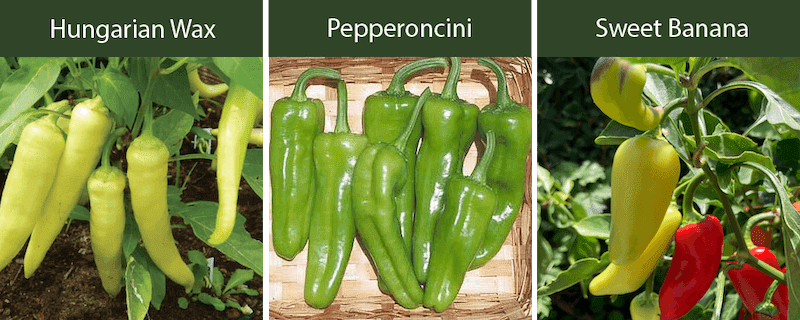
Hungarian wax pepper plants: Hungarian wax peppers are a mild to medium-hot banana pepper with a slightly sweet and tangy flavor. They have a tapered shape and a thin skin that can be yellow, orange or red. Hungarian Wax peppers originated in Hungary and are now grown in many parts of the world. The plants grow tall and vertical and can yield up to 20-30 peppers per plant. As a European pepper, they grow to their full potential in deep, well fertilized earth. Providing they receive at least 8 hours of sunlight a day, they will set an abundant amount of fruit. Wax peppers are also known as the “pickling pepper.”
Sweet banana pepper plants: Sweet banana peppers are a mild, sweet banana pepper with a slight tangy flavor. They have a long, tapered shape and a thin skin that is usually yellow in color. Sweet Banana peppers, hailing originally from South America, are now cultivated extensively in numerous regions around the globe. The plants grow taller than Hungarian wax peppers, and yield between 25-35 peppers per plant. Sweet bananas love to grow in mineral based soils. The plant needs to be deeply watered once a week to grow and fruit to its full potential.
Pepperoncini pepper plants: Pepperoncini peppers are a mild, slightly spicy banana pepper with a tangy flavor. They have a tapered shape and a thin skin that can be yellow or red in color. Initially native to Italy, Pepperoncini peppers have found a substantial cultivation footprint in the United States. The plants grow slender and tall (over 3 feet) yield up 50 peppers per plant. Pepperoncini peppers prefer well-draining volcanic soil and need at least 10 hours of sunlight per day, with nighttime temperatures between 70-85°F.
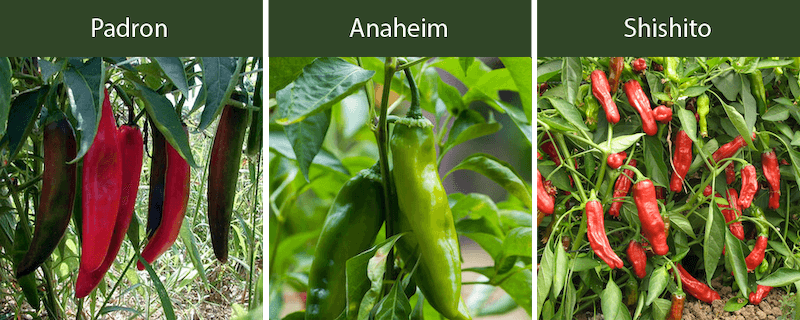
Padron pepper plants: Frying peppers are small, thin-skinned peppers that are typically mild, but can be occasionally hot. These peppers hail from the Galicia region of Spain and are commercially grown in the southwest United States and western Australia. The plants are bushy much like an eggplant producing up to 30-50 peppers per plant. As a Spanish pepper, it prefers to grow in its natural volcanic soil and grows best in a sun-filled climate that closely mimics its native country of origin. Padron peppers are frequent used to make tapas, where they are fried in olive oil and served with coarse salt.
Shishito pepper plants: Shishito peppers are small, thin-skinned peppers that are typically mild, but can occasionally be hot. They originated in Japan and are now grown in California. The plants are small and bushy producing between 30-50 peppers per plant. They prefer to grow in Mount Fuji volcanic soil and require at least 7 hours of sunlight per day, with nighttime temperatures between 65-75°F. Shishito peppers are typically served as a side dish in Japan.
Anaheim pepper plants: Anaheim peppers are a mildly spicy pepper with a thin skin and a slightly sweet flavor. They have a long, tapered shape and are commonly used in Southwestern and Mexican cuisine. Emerging from New Mexico, Anaheim peppers have expanded their cultivation across various parts of the globe. A medium sized plant (grows to a height of 2 feet), they can produce up to 30 peppers per plant given ideal growing conditions. The plants are medium-sized and can yield up to 20-30 peppers per plant. They prefer a sandy loam soil and require at least 8 hours of sunlight per day, with nighttime temperatures between 63-77°F. Anaheim peppers are used to make enchiladas and salsas.
Italian frying pepper plants: Italian frying peppers are sweet and mild, with a thin skin and a slightly fruity flavor. They have a long, tapered shape and are commonly used in Italian cuisine. Italian frying peppers originated in Italy and are now grown commercially in Florida. The plants are medium-grow tall and require trellising and can yield between 30-40 peppers per plant. Frying peppers are prolific producer given the right conditions. The like to grow in deep, well-watered, earth enriched with organic fertilizers. The also like lots of sun – around 10 hours a day.
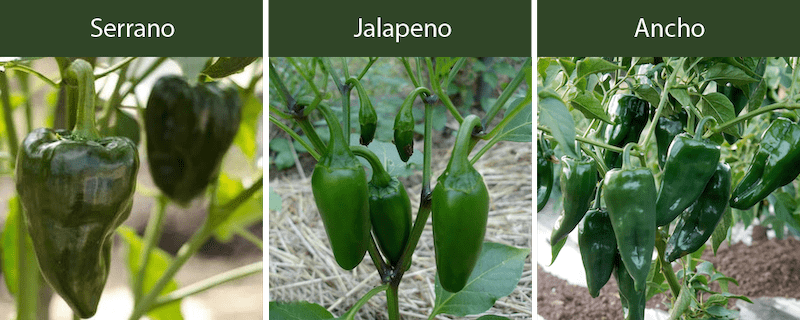
Jalapeño pepper plants: Jalapeño pepper plants yield a moderately spicy pepper imbued with a subtly smoky flavor. These peppers feature a robust skin and a sturdy, crisp texture. With roots in Mexico, the cultivation of jalapenos has now spread significantly, with California and Texas being key growing regions. The plants grow to about 2 feet and are particualrily prolific producing between 30 and 50 peppers per plant. They prefer well-draining rocky soil and need at least 9 hours of sunlight per day, with nighttime temperatures between 65-82°F.
Serrano pepper plants: Serrano peppers are a hot pepper with a slightly fruity and grassy flavor. They have a thin skin and a firm, crunchy texture. Serrano peppers originated in Mexico and are now widely grown in the southwest United States. The plants grow into medium-sized bushes and can yield up to 20-30 peppers per plant. They prefer well-draining sandy loam soil and require at least 9.5 hours of sunlight per day, with nighttime temperatures between 62-75°F. Serranos are found as ingredients in pico de gallo.
Guajillo pepper plants: Guajillo peppers are a medium-spiced pepper with a slightly sweet and smoky flavor. They have a thick skin and a slightly tough texture. Initially native to Mexico, Guajillo peppers have extended their cultivation to regions like Australia, California, and Texas. The plants are compact producing on average 15-25 peppers per plant. They grow best in sandy soil and require 9 hours of sunlight each day for a period of no less than 3 months to maximize pepper production.
Ancho pepper plants: Ancho peppers are a mild to medium-spicy pepper with a slightly sweet and smoky flavor. They have a thick skin and a slightly tough texture. Ancho peppers are actually dried poblano peppers commonly used in Mexican cuisine. The plants are small and bushy producing on average 12 to 22 peppers per plant. They prefer sandy desert soil and require at least 10 hours of sunlight per day, with nighttime temperatures between 65-81°F.
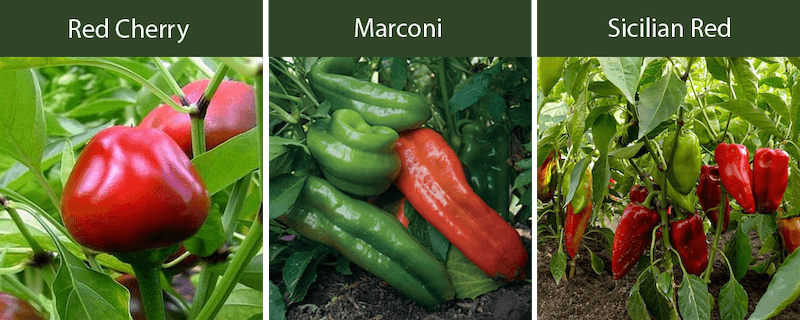
Sicilian pepper plants: These peppers have a long, tapered shape and are similar in appearance to the Marconi pepper. Sicilian peppers originated in Italy and are now grown in the Middle East. The plants are medium-sized and produce between 20-30 peppers per plant. They prefer well-draining soil and require at least 11 hours of sunlight per day, with nighttime temperatures between 66-78°F. Sicilian peppers are commonly used in Italian cuisine, especially in dishes like pasta alla norma and grilled peppers.
Marconi pepper plants: These peppers have a long, tapered shape and are similar in appearance to the Marconi pepper. Sicilian peppers originated in Italy and are now grown in the Middle East. The plants are medium-sized and produce between 20-30 peppers per plant. They prefer well-draining soil and require at least 11 hours of sunlight per day, with nighttime temperatures between 66-78°F. Sicilian peppers are commonly used in Italian cuisine, especially in dishes like pasta alla norma and grilled peppers.
Italian red cherry pepper plants: Italian red cherry peppers are a mildly spicy pepper with a thin skin and a slightly sweet and tangy flavor. Boasting a round form and approximately the size of a cherry, Italian Red Cherry peppers find their origins in Italy but are now cultivated across various regions around the planet. The plants are small and bushy and can yield up to 50-60 peppers per plant. They prefer well-draining volcanic soil and require at least 10 hours of sunlight per day, with nighttime temperatures between 65-80°F. Red Cherry peppers are primarily used to make pickled peppers.
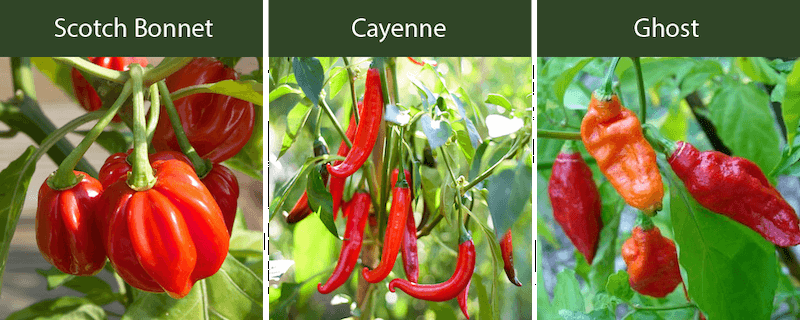
Habanero pepper plants: These peppers are a very hot pepper with a fruity and floral flavor. They have a thin skin and a firm, crunchy texture. With their circular shape and similar size to cherries, Italian Red Cherry peppers originated in Italy but have since extended their cultivation to numerous parts of the planet. The plants are big and bushy particularly in the Caribbean and can yield more than 50 peppers per plant. They prefer volcanic, well-draining soil and require at least 9 hours of sunlight per day, to build maximum heat with nighttime temperatures between 70-80°F. Habanero peppers are used to create hot sauces.
Ghost pepper plants: Known as one of the spiciest peppers worldwide, Ghost peppers offer a smoky taste with a hint of sweetness. Their thin skin encapsulates a firm, crunchy interior. Originating from Northeast India, these peppers have now spread their cultivation to various regions around the globe. The plants are relatively small and around 20 peppers per plant. They prefer wet loamy soil with a high decomposition count and require 9 hours of sunlight per day, with nighttime temperatures between 70-80°F, which mirrors night temperatures in India.
Scotch Bonnet pepper plants: These peppers are a very hot pepper with a fruity and slightly sweet flavor. Their skin is thick firm. Scotch Bonnet peppers originated in the Caribbean and are now grown worldwide where the climate is suitable. The plants are small and bushy producing 20-30 peppers per plant. They prefer volcanic soil and require 9 hours of sunlight per day, with nighttime temperatures between 65-75°F (typical temperatures in the south Caribbean). Scotch Bonnet peppers are commonly used in hot sauces, marinades, and in dishes like jerk chicken.
Thai Bird's Eye pepper plants: These peppers are a hot pepper with a slightly fruity and citrusy flavor. They have a thin skin and a firm, crunchy texture. Thai Bird's Eye peppers originated in Southeast Asia and are now grown commercially in Australia. The plants are small yield up to 50-60 peppers per plant. They prefer well-draining, sandy soil and require at least 6 hours of sunlight per day, with nighttime temperatures between 70-80°F. Thai Bird's Eye peppers are commonly used in Thai cuisine, especially in dishes like curries and stir-fries.
Cayenne pepper plants: These peppers are a hot pepper with a slightly fruity and citrusy flavor. They have a thin skin and a firm, crunchy texture. Thai Bird's Eye peppers originated in Southeast Asia and are now grown commercially in Australia. The plants are small producing up to 50-60 peppers per plant. They prefer to grow in warm, mineral-rich earth in regions with lots of sunshine. well-draining, sandy soil and require at least 6 hours of sunlight per day. Thai Bird's Eye are used to prepare curries and stir-fries.
Peppers are a versatile vegetable plant with a range of flavors, colors, and heat levels that make them a popular addition to gardens and profitable crop for farmers. Pepper plant varieties include popular bell peppers, hot jalapeños, even hotter habaneros, serranos, and cayenne peppers. Peppers are relativity easy to grow with the right soil, fertilizer, and sunshine. They are typically harvested throughout the summer and fall. Peppers possess exceptional flavor profiles, vibrant colors, and varying heat levels, which contribute to their status as a highly prized crop. However, cultivating peppers necessitates meticulous care to effectively address challenges such as pests, diseases, and the impact of severe weather conditions. Growing peppers in a Crop Circle Garden or on a Crop Circle Farm can offer some protection from the elements.